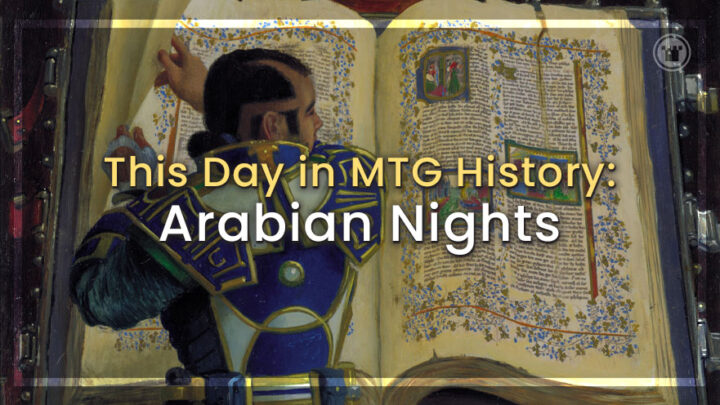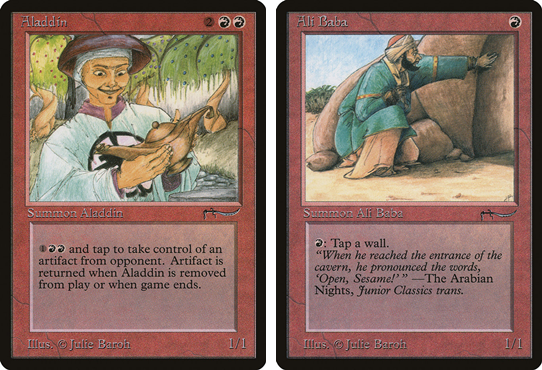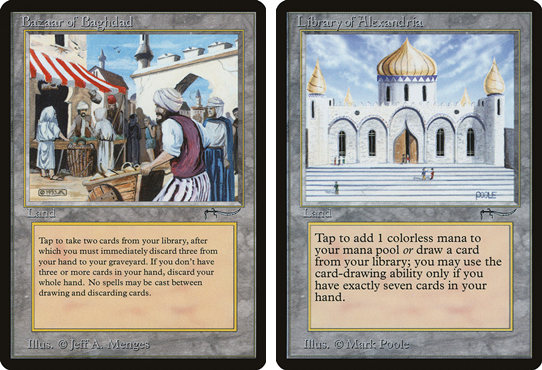Welcome to another edition of “This Day in Magic History.” Today is the 29th anniversary of the release of the very first Magic expansion: Arabian Nights.
Before its release on Dec. 17, 1993, there was only one set of Magic cards (Alpha, Beta, Unlimited) printed several times. The release of an expansion was a major moment in the history of Magic and TCGs in general! In this article, we’ll look at the development and design of Arabian Nights, its unique setting, some of its important cards and its legacy today.
Developing Arabian Nights
Magic was, of course, the world’s first trading card game, and that meant Arabian Nights was the first expansion for a TCG or a CCG. This meant that, initially, Richard Garfield and company weren’t really sure how to release it.
At first, Arabian Nights was going to be a stand-alone product that had nothing to do with Alpha, Beta and Unlimited. It was going to use the rules of Magic, but in a completely different setting with a different card back! This might sound like a horrible idea to us today, but that’s only because we have the benefit of hindsight.

Ultimately, the developers decided to release Arabian Nights with an identical card back to Alpha, Beta, and Unlimited. This set an important precedent, and this model of releasing expansions was adopted by all future CCGs and TCGs.
The Real-World Setting of Arabian Nights
Alpha used a fairly generic fantasy setting and was set in a multiverse called “Dominia,” but Arabian Nights went in a very different direction. As you can probably guess from the name, it actually used our real world as its setting!
Specifically, the set is inspired by One Thousand and One Nights, a medieval Arabic literary work. It is a collection of stand-alone stories that are interconnected by a single frame story.
Each of these stories is narrated by a woman named Shahrazad. She has the unfortunate fate of having married a cruel man who marries a new virgin every night and has her beheaded the next morning before she can cheat on him.
Shahrazad, though, finds a way around this. She tells him a story every night and makes sure to end each one on a cliffhanger so he has to come back the next day to hear more of the story. This also means she gets to keep her head!
The set features several characters from One Thousand and One Nights, including Aladdin, Ali-Baba and Shahrazad herself.
Some of her stories also feature historical figures, and so, too, does Arabian Nights! The most notable of these is All-Hajjaj ibn Yusuf (El-Hajjaj), a seventh-century regional governor for the Umayyad Caliphate.
In the early 2000s, in order to make it fit in with other Magic releases, Arabian Nights was retconned out of the real world. Now, it is said to take place on a collection of one thousand and one planes called “Rabiah.” Each of Shahrazad’s stories takes place on one of these planes. This preserves the original inspiration of the set while disconnecting it from the real world.
The Rabiah Scale
The unique setting of Arabian Nights means it is a plane that we will likely never visit again. In 2016, Mark Rosewater created a ranking of planes that he calls the “Rabiah Scale,” where he ranks all of Magic’s planes based on whether we will ever revisit them.
It is similar to his “Storm Scale,” which measures whether we will see mechanics again. He calls it the “Rabiah Scale” because that is a plane we will definitely never see again because it doesn’t feature intellectual property owned by Wizards of the Coast.
The Two Most Important Cards in Arabian Nights
Arabian Nights is almost 30 years old and it only has 92 cards, but some of the set’s cards have really stood the test of time and still see play in the Eternal formats today! It just so happens that the two most important cards in the set are named for real-world locations: Bazaar of Baghdad and Library of Alexandria.
Both Alexandria and Baghdad are important cities in the modern world. While the Library no longer exists, it was one of the major centers of learning in the world for centuries.
These are two of the most powerful lands in all of Magic. Bazaar of Baghdad doesn’t even produce mana, but it would be kind of crazy if it did because it has such a powerful effect.
You can tap the Bazaar to draw two cards and discard three cards. It is a key card in Vintage Dredge and Bazaar Aggro decks, which can turn everything they discard into value. For those decks, it is almost like you can tap the Bazaar and draw five cards, and you don’t need me to tell you how busted that is. That’s why the Bazaar is banned in Legacy.
Library of Alexandria is also a card drawing engine. You can tap it to draw a card as long as you have exactly seven cards in your hand. This is especially sweet for control decks, which like to hold on to a whole bunch of cards. The Library isn’t as important these days as it used to be, but it does remain banned in Legacy and Commander, and it is restricted in Vintage!
End Step
There is a pretty good argument for Arabian Nights as the second most important set in Magic history (just behind Alpha). It introduced the very idea of an expansion set, something that has really shaped Magic and all other TCGs in the years since.
That’s all for this week, I’ll be back next week with a special Chanukah EDH deck!

Jacob has been playing Magic for the better part of 24 years, and he especially loves playing Magic’s Limited formats. He also holds a PhD in history from the University of Oklahoma. In 2015, he started his YouTube channel, “Nizzahon Magic,” where he combines his interests with many videos covering Magic’s competitive history. When he’s not playing Magic or making Magic content, he can be found teaching college-level history courses or caring for a menagerie of pets with his wife.





